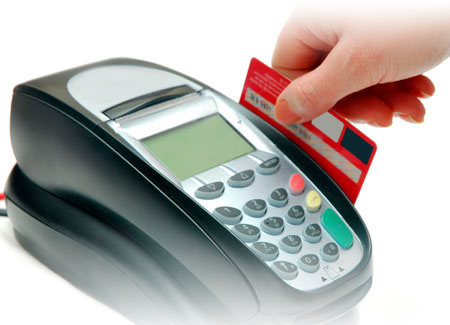The Chargeback Process
Chargebacks occur when a cardholder disputes a charge to his credit card payment processing account. The diagram below represents the chargeback cycle.

Overview
A chargeback is a transaction that an issuer returns to a merchant bank – and most often, to the merchant – as a financial liability. In essence, it reverses a sales transaction, as follows:
- The card issuer subtracts the transaction dollar amount from the cardholder?ÇÖs credit card account. The cardholder receives a credit and is no longer financially responsible for the dollar amount of the transaction.
- The card issuer debits the merchant bank for the dollar amount of the transaction.
- The merchant bank will, most often, deduct the transaction dollar amount from the merchant?ÇÖs account. The merchant loses the dollar amount of the transaction.
For merchants, chargebacks can be costly. You lose both the dollar amount of the transaction being charged back and the related merchandise. You also incur your own internal costs for processing the chargeback. On top of that, if your chargebacks exceed one percent of the total number of your sales transactions, your merchant account will be suspended and ultimately, closed down. Credit card processing companies get fined by the Associations when their merchants have excessive chargeback levels and are very strict in monitoring them.
Chargeback Reasons
The most common reasons for chargebacks are:
- Customer dispute. A customer may dispute a transaction because a credit was not issued when the customer expected it to be; merchandise was not received; a service was not performed as expected; the purchase was fraudulent. Most of these reasons indicate customer dissatisfaction and addressing their causes should be an integral part of your sales and customer service policies. Please refer to the “Transaction Processing” section of our Payment Card Acceptance Best Practices Guide for additional information.
- Fraud.
- Processing errors.
- Improper authorization.
- Inaccurate transaction information.
Although you probably cannot avoid chargebacks completely, you can take steps to reduce or prevent them. Many chargebacks result from easily avoidable mistakes, so the more you know about proper transaction-processing procedures, the less likely you will be to inadvertently do, or fail to do, something that might result in a chargeback. Always ask your credit card processing service provider for help.
Your Responsibility
The main interaction in a chargeback is between the card issuer and the merchant bank. The issuer sends the chargeback to the merchant bank, which may or may not need to involve the merchant who submitted the original transaction. This processing cycle does not relieve merchants from direct responsibility for taking action to remedy and prevent chargebacks. In most cases, the full extent of your financial and administrative liability for chargebacks is spelled out in your merchant agreement.
Chargeback Remedies
Even when you do receive a chargeback, you may be able to resolve it without losing the sale. Simply provide your merchant bank with additional information about the transaction or the actions you have taken related to it. For example, you might receive a chargeback because the cardholder is claiming that credit has not been given for returned merchandise. You may be able to resolve the issue by providing proof that you submitted the credit on a specific date. Send this information to your merchant bank in a timely manner.
Avoiding Chargebacks
Most chargebacks result from inadequate payment processing procedures and can be prevented with appropriate training. The following best practices will help you minimize chargebacks.
- Always conduct an Address Verification Service (AVS) check and ensure that you received a ?Ç£positive AVS,?Ç¥ i.e. Address + 5 ZIP or Address + 9 ZIP.
- Only ship to a billing address with an approved AVS response.
- Obtain evidence of receipt of goods (e.g. signed shipping receipt).
- Use ?Ç£Verified by Visa?Ç¥ and MasterCard?ÇÖs ?Ç£SecureCode?Ç¥ programs (for eCommerce merchant accounts only), which guarantees the card was used legitimately by its owner and gives you strong representment rights.
- Require a Card Verification Code (CVC2, CVV2 or CID), the 3- or 4-digit code on the back of the card (or on the front for American Express cards).
- Process refunds as quickly as possible.
- Notify consumers in writing (e-mail or regular mail) when a refund has been issued or a membership canceled. Provide them with the date of refund and a cancellation number, if applicable.
- Always provide a clear billing descriptor and phone number so the consumer can contact you directly rather than calling their bank to discuss any dispute.
- State terms and conditions of the sale (or membership) clearly and in plain view.
- Use e-mail to notify the consumer at each billing cycle.
- Obtain a signature from the cardholder giving you permission to charge their card on a regular basis for monthly fees or recurring payments.
- Make it very easy for members or subscribers to cancel ?Çô have a “no-questions-asked” policy.
- Authorizations must always be done for every deposit.
- Deposits must not exceed the amount you have authorized.
- Authorizations must be “positive.”
- Avoid using voice authorizations.
- Avoid recycled authorizations?Çô get a new authorization for each deposit.
- If you are settling a transaction with an authorization more than 7 days old, you must reauthorize the transaction. You may receive a better interchange rate because the authorization will be closer to the date of the deposit.
![]()
















